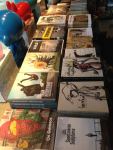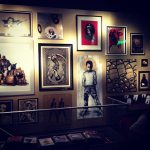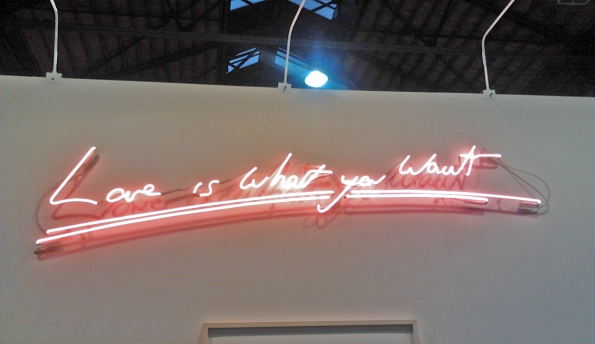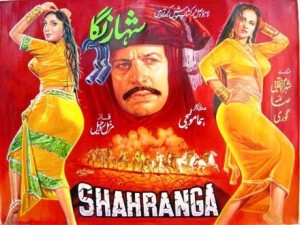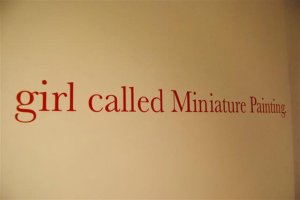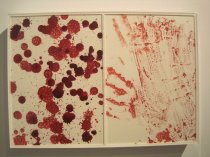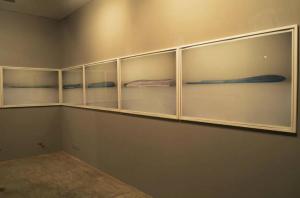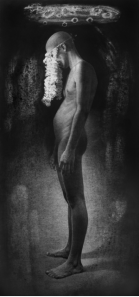OUTLOOK: WHAT WERE THE ISSUES THAT PAKISTANI ARTS GRAPPLED WITH IN 2014? The Herald Annual takes a look back on the year 2014 to see what were the big stories in Theatre, Films, Art, Books and Television. – Herald Annual Issue, January 2015
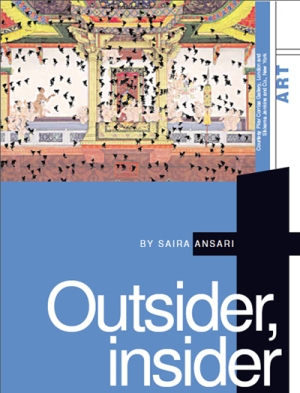
OUTSIDER, INSIDER
By Saira Ansari
The year 2014 has closed on an immensely dark note, with the terrorist attack on a Peshawar school casting a long and dark shadow on our reflections of achievements and losses on both a private and public level. It feels pertinent, then, to start an essay on the politics of identity in the art world with the very issue that plagues the whole nation — identity crisis.
Without creating confusion by spewing clichés, this article tries to take a circumstantial approach and looks at a few key events and published texts. These handpicked examples are by no means representative of identity politics and it is also quite likely that many other cases that fit the bill have been left out due to lack of space and time. It is, however, important to consider that the article references examples that have been the subject of much debate in multiple public forums in the recent past.
To tackle the most current manifestation of the subject of identity politics in art, it makes sense to start with the contentious Shahzia Sikander issue. For those not familiar with it, here is a brief background and context: Sikander is an artist with notable and consequential contribution to the neo-miniature movement. She started experimenting with miniatures in medium, scale and in the introduction of Western iconography back in the 1990s — about a decade before the current wave of contemporary miniature oeuvre started stemming from Pakistan. It is safe to say that her practice has been at the forefront of contemporising miniature painting, and catapulting it into the limelight in an international arena, as well as back home in Pakistan. The precedent, it can be rightfully argued, had been set by her teacher, Zahoor ul Akhlaq, an art star of now mythic proportions.
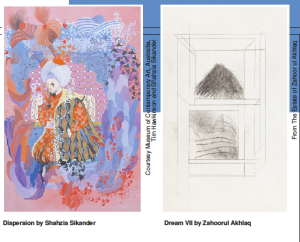 Herein lies the supposed problem — Sikander left Pakistan to pursue a Masters degree in Fine Arts at the Rhode Island School of Design in 1995 and ended up staying and practicing in the United States. She engaged with the international audience at a time when the concept of a diasporic artist was still not clearly established, or even recognised, back home. In addition to that, many of Sikander’s interviews spoke about the blurring of boundaries and of working outside (and I paraphrase) the ghettoisation of South Asian artists in the postcolonial context. In a nutshell, her stance was clear about her work not being confined to any ethnographic labels applied to her. That, and the physical absence from Pakistan’s teaching field – a custom almost universal among practicing artists in Pakistan, especially those in Lahore – meant that she was slowly, but very surely, ostracised from the historical narrative of contemporary art in Pakistan over the years, one that has largely been based on anecdotal evidence. Students knew about her, artists spoke of her and there was a vague impression of her presence in the background, but she slipped through the cracks in lectures on contemporary art and lost significance in published texts about the art of the country. Post 9/11, when Pakistan was flung begrudgingly into the centre of the global stage, art from the country gained impetus and attention from newer audiences. Avenues for travel, production, collaboration and exhibition increasingly became accessible and a new wave of artists filled in these roles, leaving Sikander’s part of the story on the sideline.
Herein lies the supposed problem — Sikander left Pakistan to pursue a Masters degree in Fine Arts at the Rhode Island School of Design in 1995 and ended up staying and practicing in the United States. She engaged with the international audience at a time when the concept of a diasporic artist was still not clearly established, or even recognised, back home. In addition to that, many of Sikander’s interviews spoke about the blurring of boundaries and of working outside (and I paraphrase) the ghettoisation of South Asian artists in the postcolonial context. In a nutshell, her stance was clear about her work not being confined to any ethnographic labels applied to her. That, and the physical absence from Pakistan’s teaching field – a custom almost universal among practicing artists in Pakistan, especially those in Lahore – meant that she was slowly, but very surely, ostracised from the historical narrative of contemporary art in Pakistan over the years, one that has largely been based on anecdotal evidence. Students knew about her, artists spoke of her and there was a vague impression of her presence in the background, but she slipped through the cracks in lectures on contemporary art and lost significance in published texts about the art of the country. Post 9/11, when Pakistan was flung begrudgingly into the centre of the global stage, art from the country gained impetus and attention from newer audiences. Avenues for travel, production, collaboration and exhibition increasingly became accessible and a new wave of artists filled in these roles, leaving Sikander’s part of the story on the sideline.
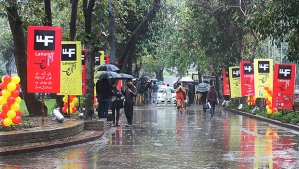 The debate over identity in art, however, continued and the Sikander issue resurfaced in a much talked about incident at the Lahore Literary Festival in early 2013 where art critic, teacher and artist Quddus Mirza said, at a panel discussion titled Polemics of Time and Space, that Sikander was not a Pakistani artist as she had not engaged with the Pakistani art community. The statement, although not made for the first time, received a fair amount of criticism from the audience in attendance. Following the event, the disapproval of his statement gained momentum and was recounted in everything — from casual conversations within the art fraternity, to blog posts and published texts. Many cried jingoism. Poignantly, it was the resultant discord which forced people to reconsider the ownership of narration and the formation of identity resulting from it, and to stand up against what was being considered a pigeonholed and political opinion of a few.
The debate over identity in art, however, continued and the Sikander issue resurfaced in a much talked about incident at the Lahore Literary Festival in early 2013 where art critic, teacher and artist Quddus Mirza said, at a panel discussion titled Polemics of Time and Space, that Sikander was not a Pakistani artist as she had not engaged with the Pakistani art community. The statement, although not made for the first time, received a fair amount of criticism from the audience in attendance. Following the event, the disapproval of his statement gained momentum and was recounted in everything — from casual conversations within the art fraternity, to blog posts and published texts. Many cried jingoism. Poignantly, it was the resultant discord which forced people to reconsider the ownership of narration and the formation of identity resulting from it, and to stand up against what was being considered a pigeonholed and political opinion of a few.
The questions that arise from this one example are many and complex. What are the characteristics that define a Pakistani artist? What is Pakistani art? Is there a singular definition of Pakistani art? Are there two, perhaps three, definitions? And finally, what are the precise indicators for the demarcation of art belonging to a certain space? There is even the risk of traversing into murkier waters — does an artist have a responsibility towards his/her country, culture, or audience? Keeping in tune with the intermediate level of this article’s dialogue, it is prudent to skip the beginners’ responses to these queries, per se. There are no clear answers stating ‘a is equal to b’. There are, however, understandings and approaches to these strains of interrogations — those that are best explored in sociological and anthropological contexts of identity in art history. To begin any such inquiry, however, one must be willing to accept the possibility of simultaneous conditions that coexist even when they are divergent from each other.
Which brings one to a more pressing concern — the commodification of identity and culture as the tour de force of contemporary art. In doing so, there is a risk of marginalising important and critical practices that are devoid of national narrative. That is to say, a Pakistani artist should hypothetically be able to make critically and/or commercially successful work about aliens from outer space, without ever referencing regional politics, history, culture, iconography or even any correlation with the current times. Why not? The act merely implies that the artist has an acute interest in aliens, and has explored it in a medium of his or her choice. The work could putatively be brilliant in thought, execution and presentation. It could then be presented at an international platform, and if one were to miss the small print indicating ‘Artist X lives and works in Pakistan’, the work would be unclassifiable as from, or about, Pakistan. In such a situation, does the artist become any less Pakistani? Does his/her educational experience and influences, as well as exposure to immeasurable local stimuli, become stripped of any significance? A reasonable, logical answer would be no. Does the work fit in the discourse of contemporary Pakistani practices? Yes. Would it work itself into a potential curatorial project on defining Pakistani response to global politics and its repercussions at home? Perhaps yes, that is, if the artist and curator thought it befitting; traditionally, maybe not.
Why, then, is the desire to cast the current and new breed of practitioners from Pakistan into a generic mould? This leads to the personal politics, briefly referred to earlier, as the anecdotal aspect involved in the writing of art history. The popular opinion is that the questioning of Sikander’s identity is a form of self-promulgation by a group of successful artists, who also teach, to create a lineage of a practice that they have fathered. Others suggest it is much more to do with isolating those voices and practices that have fallen out of favour with the key players in the art fraternity. Sikander has acknowledged this cold-shouldering on multiple public platforms and interviews, and more so since the 2013 incident. In an almost symbolic move, she was present at the 2014 edition of the Lahore Literary Festival, where she was given a stage to present her work and offer the local audience the chance to interact with her on a one-on-one basis. Several local publications used this opportunity to present ‘the other side of the story’ on the question of her identity but the heated politics of opinion was never far from this discourse.
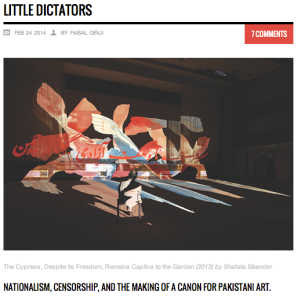 Also in February last year, Faisal Devji – a scholar of intellectual history, political thought and modern Islam in India, Pakistan and the Muslim world – wrote in Newsweek Pakistan about the exclusivist traditions of writing in the art history texts on Pakistani art. In specific, he chose to highlight the Sikander issue to comment upon the writings of three art historians and critics — Iftikhar Dadi, Virginia Whiles and Quddus Mirza. The article, however, assumed an accusatory tone even before it started — it was titled Little Dictators.
Also in February last year, Faisal Devji – a scholar of intellectual history, political thought and modern Islam in India, Pakistan and the Muslim world – wrote in Newsweek Pakistan about the exclusivist traditions of writing in the art history texts on Pakistani art. In specific, he chose to highlight the Sikander issue to comment upon the writings of three art historians and critics — Iftikhar Dadi, Virginia Whiles and Quddus Mirza. The article, however, assumed an accusatory tone even before it started — it was titled Little Dictators.
While Devji brought up a host of crucial points, basing his premise on the very legitimate argument of Sikander’s absence from critical text, he ended up rubber-stamping the text as personal vendetta. The article appeared as if from thin air, with little paper trail on the writer’s attempts at partaking in this discourse earlier. One can imagine that if he had refrained from making unusual accusations (that went as far as claiming that Dadi indulged in sectarian partisanship) and provided a meeting ground where he asked for a scholarly response from either of the parties he mentioned, the dialogue would have been more helpful. Rather than letting the reader focus on the strength of his claims, his piece ended up culling the response: What is the story that lies behind such a sudden and caustic attack? There is much to glean from the responses that followed by Dadi and then Whiles. These were posted in the comment section of the online version of the article, and also shared on various social media platforms. Dadi engaged the article in a point by point defence, providing reasonable arguments for the most part but also expressing outrage over the “unbalanced attacks on the too few…who are seriously committed to the art history of Pakistan”. He perhaps was seeking immunity for the privilege of belonging to the small club. Whiles’ response mostly only carried her outrage, with not enough context to convince an unbiased audience willing to give each party the benefit of the doubt to explain themselves.
This chain of events and the countless conversations it has started or ended in the past two years forces us to evaluate what is happening around us far more critically, starting with analysing what is being taught at art schools. The art world is seen gripped in the fast-paced throes of the capitalist success format, where the financial worth of art stands in for its critical worth. This is also trickling into education modules where students aspire to reach that level of success as achieved by their teachers, and there is no theoretical argument presented to them that will inform them otherwise. Therefore, there is a real risk of the current market trend – which in the last decade or so is based on an incredibly fetishised consumption of the Pakistani-ness of art, both in style and content – dictating the way students perceive, process and digest the production of a Pakistani identity within art.
To sum up, the deliberations around identity politics in the Pakistani art world are akin to a nationalistic debate. But the trouble with nationalism is that it is not inclusive, positions everything under blanket definitions, rejects minorities, and is not open to the idea of blurring boundaries to move towards a broader dialogue. In order to foster progressive trajectories in art practice, art theory and the writing of art history, we must be able to move beyond limiting definitions and tropes that have been passed down to us in Chinese whispers. It is not an inheritance we must accept as gospel, without the resolve to understand the nature of it, or to investigate alternate realms of thought.
*Image courtesy Canvas Gallery (Khi) – From the exhibition Non-Commissioned Portraits and Landscapes
Considering how I’m feeling lately and taking into account what my country is going through these days (and it seems always), it’s no wonder that this work by Ayaz Jokhio struck a deep chord within me. His Karachi also reminds me of another – Karachi by Night, a 1956 painting by Modernist painter Zubeida Agha, has always always held a powerful hold on me. In an odd-ish way, this is an ode to a city that’s never been my home.
Apologies – my usual snarky self is on a blogging hiatus. As always, there is much to say – but …
________________________
- Visit The s.a. Project Facebook page for regular updates
- Join in the much more interactive and constant discussion at twitter – SairaAnsariPK
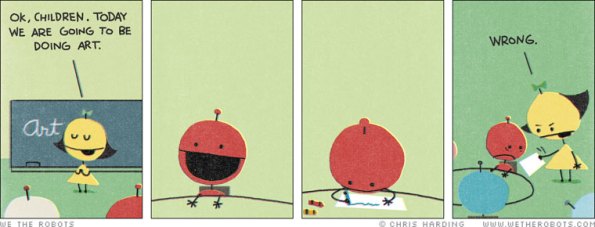
A few days ago, my friend (and 39k gallerist) Abdullah Qureshi (aka BonBon Liholmen) posted a small link on his Facebook page. It was an open letter directed at Quddus Mirza, and printed in a new newspaper ‘The Spokesman‘. I was intrigued and clicked the link to read micro-miniscule letters that made me cross-eyed. So I promptly sent Abdullah a message asking him to send me a better link or the text. He sent it back, I read it, then I gaped open-mouthed at my screen and did a little virtual congratulatory back pat for Mr. Bonbon.
In his letter, he simply stated all that he thought went wrong with the Arts discussion ‘Polemics of Time and Space II‘ at the Lahore Literary Festival 2013. According to the LLF program, it was a “Multimedia presentation of Modern and Contemporary Visual Arts by Quddus Mirza followed by a panel discussion” – Panelists: Amin Jaffer, Rashid Rana, Naazish Ataullah, and Dr. Dina Bangdel; Moderator: Salima Hashmi
Just a few days prior to Abdullah’s letter, I had read Fayes T. Kantawala‘s review of the Lahore Literary Festival, OMG LLF, and his disappointment regarding the same talk.
Excerpt from OMG LLF:
The second session was delivered by Quddus Mirza, which I think deserves some kind of official apology. It was of a level so banal that there were involuntarily physical reactions in the audience. I’ll skip most of my gripes and go straight to the hernia: he began the lecture with a massive high-res slide of the artist Shahzia Sikander’s work. “Sikander is not a Pakistani artist because she doesn’t engage with the community,” he said dismissively, and then moved on to sad jokes and painful non-sequiturs about Pakistani art.
Hold up. If Shahzia Sikander is so irrelevant to art today, why did you just open your lecture on Pak Art with A SLIDE OF SHAHZIA-DON’T-MATTER-WHO-SHE-IS-SIKANDER? To those who don’t know, Shahzia Sikander is the most globally eminent artist to emerge from Pakistan. Ever. For some reason, the local art mafia has taken it upon themselves to exclude her from what they consider Pakistani Art, I imagine because she doesn’t exhibit here (would you if the MoMA was buying you?) and a whole host of personal vendettas that have nothing to do with her body of work. That’s fine. Everyone is entitled to their opinion, even if it’s s***. What’s deeply petty is to single her out in a general introduction on art for Lahore’s first literary festival, just to say she’s isn’t one of us, when she is in fact believed by the world (let me say it again: the world) to be our best.
Later, a panelist who was a curator from Doha opened the discussion by pointing out that Sikander is actually the biggest name associated with Pakistani art, so she found the hostility against her in her own hometown remarkable. The session marked the petty small-mindedness that so often surface when Lahoris gather in public. I am thrilled to say it was the only one.
I really enjoy Kantawalla’s posts and writing in general, including this one – however, I had gauged this critique to be more about the schism issue in the talk (is Shazia Sikander Pakistani or not. I have had this conversation with so many people, and everyone has different sentiments – but more on that in the proverbial future).
But Abdullah’s letter made me sit up. And react. I promised Abdullah I’d post it. Not as an attack on Quddus Mirza – because that’s never my intention, neither do I have any personal issues with QM. In fact, I do have a pretty good relationship with him. But I wanted to post it because it was after a very LONG time that I have read a mature and sound counter-argument in the Pakistani art world. Abdullah disagreed with the dynamics of the whole talk and felt that he needed to address this – not in small little circles huddled in private gallery corners, not in an art bitchfest, and not to his clique. He wrote directly to Quddus Mirza, and had it published at a public forum. He initiated a dialogue.
From that day of our conversation to now, that article has been shared all over Facebook and other social media. So my post here is basically for those who missed out on it, and also as a celebration of young Pakistani people in the art world writing and expressing themselves. It’s a breath of fresh air, even though many might as usual interpret this as offensive and controversial. To them I say – go drink thandi chai. Because that’s what art is without discourse.
I’m reposting the letter here. It can also be read online here at its original home -> The Spokesman: Open Letter to an Artist – Abdullah Qureshi. Since Abdullah agreed for me to publish the whole thing, I’m adding this in my Guest Write-up section.
Dear Quddus Mirza,
I am writing a slightly late but necessary response to ‘Polemics of Time and Space II’ at the Lahore literary festival. While the entire festival was highly anticipated, this presentation and discussion was what I looked forward to most. Unfortunately, this was a waste of an hour and clearly quite agitating at that.
Salima Hashmi, the moderator, introduced you as ‘one of the foremost if not the foremost art critic of Pakistan’. Only something great should have followed. It didn’t. However exhausting the festival was, your “hangover” from the prior talk was unjustified. You should have been prepared. Irrespective of the many well-read and knowledgeable individuals present, this was insulting. Instead of an experience that could have been enlightening, one left in a state of disappointment. This session came across as a filler; attempting to promote certain individuals and exposing the politics that the art world is often accused of.You began by presenting a personal history of contemporary art. What do you mean by “personal”? How is history ever personal unless it is autobiographical? Did you mean you were showcasing artists affiliated with you or those you had been in contact with? You continued talking about several traditions in the history of Pakistani art but except for the miniature you focussed only on thematic work. What was further infuriating was your need to explicitly illustrate the visible. We know what a fallen plane looks like; there is no need to reiterate.
Good that we are touching upon topics that have been taboo for so long in the region. However, images of couples intimately lying together, followed by cheeky jokes undermined the seriousness of the art. Who did you think you were presenting this dumbed down and diluted history of contemporary art to? This entire charade was followed by a brief panel discussion, hardly making sense. The session was cut short and Mrs. Hashmi ended with an excuse by saying, ‘We had not planned for a Q&A in this session’.
Your only significant point was regarding the use of the term “artists from Pakistan” instead of “Pakistani artists”. I agree that limiting art makers in such a category is counter-productive and is probably only done for commercial reasons. However, you failed to elaborate on this. You mention how Frank Stella is Frank Stella and not merely an American painter. Sure! Except for the fact that the artists presented had nothing to do with Stella whose work is a direct response to the abstract expressionist movement. Here we are drifting away from ideas of representation and dealing with the picture as an object.
The practitioners you showcased are in fact interested in the socio-political. The world has certainly become a different place since 9/11 but it is incredibly naïve to define art produced since then as a tradition. Traditions of art have more to do with our history and the history of art collectively. A lot of these works are mere depiction of stereotypes. Not all of it is art. To mislead the public locally and abroad that this is all contemporary art from Pakistan is fraudulent.
In recent years, the influence of media in the art produced in Pakistan has become apparent. One sees the planes you refer to along with other symbols representative of war and perceived Islamicisation; Taliban, guns, burqas, drones even the US flag. Some of these were visible in the early works of Shahzia Sikander and continue in works of Faiza Butt and Waseem Ahmed. However, since then the use of these themes – the word I hate most being deliberately used in the context – has become “mainstream culture”.
The heavy use of such imagery especially by miniature painters has led to what we now call “modern miniature”, problematic because the media projection of us now defines our identity. You discuss Shahzia Sikander as no longer being a Pakistani artist. The issue at hand is not that she is Pakistani or not but her concerns in art. While her content is still rooted in the South Asian region, the engagement is much broader. The location is an important concept, it was observed by Naazish Ataullah, but it does not affect Sikander’s practice and why should it? The relevant question to ask here is what “modern” and “contemporary” means to us. Only then will we start understanding what our contemporary culture has become.
As a critic you are certainly allowed to have your own opinions but then it is also your professional responsibility to be honest with your critique. In your brief introduction you mentioned several traditions of art in Pakistan. However, the artists presented were specific practitioners. This biased historical account is unjust to us as the audience, consisting of artists, young students and the general public interested in learning. This process of manipulation and a selective use of history that is to your benefit, is at the expense of future generations.
This corruption that you cause in the cycle of knowledge must stop and, frankly speaking, we have had enough. People are interested in genuine debates; we need a critical dialogue. Many industries and institutions have been ruined due to the vested interest of individuals. Please don’t be one of them. Gone are the days when you could fool people by using a few foreign terms and get away with it. We live in a time where everything is a click away and the audience is much better informed.
We need experienced people like you to look up to instead of becoming a joke. This aggravates me because I care and I am sure that I am not alone. This is also a broader message to other young people in the arts to be sent out there. The more pluralistic this environment is, the more enriching it will be. We need more voices and hopefully those that disagree. Only then can we look forward to a future art scene that is going to be diverse and genuinely relevant in global debates.
So here’s to more and more and more fresh, honest opinions. Because being opinionated is a much better than being a sycophant.
Thank you BonBon.
________________________
NEXT ON THE s.a. PROJECT: Art week Dubai and everything related. In my opinion!
________________________
- Visit The s.a. Project Facebook page for regular updates
- Join in the much more interactive and constant discussion at twitter – SairaAnsariPK
I tend to follow Art World news like it’s The Bold and the Beautiful. I get off on the gossip and intrigue, on the meteoric rise and spectacular crash of artists as they make their way through galleries and art fairs, only to be spat out like used Kleenex. It’s a savage world, built on delicacies and theories and aloof elitism. I stepped briefly into it while living in New York, the art world of art worlds made famous in every movie ever (Great Expectations has a particularly unrealistic take on it) and it took me about five minutes to figure out that, much like in Pakistan, the “global art world” consists of some 50 people, all of whom know one another and none of whom are likely to invite you to a party should you nudge them.
This week my news feeds were set aflame with the announcement that…
View original post 794 more words
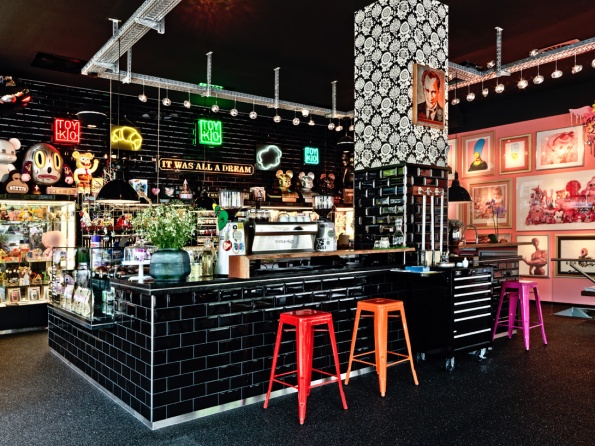
TOYKIO gallery – Image courtesy TOYKIO.de website
At the moment, I’m living one block down from possibly the coolest bloody art gallery-cafe in the whole fucking world: TOYKIO. It showcases ‘Urban Art Scene, Lowbrow Art, Pop-Surealism und [and] Photography’. Occasionally, it shows ‘Editions & Multiples of Artists like Banksy, JR, Mark Ryden, Shepard Fairey, Ricky Powell, Swoon & D*face – just to name a few.’
So there are artworks on the walls and the gallery downstairs, lots and lots of books on shelves and tables, countless limited edition artist series toys and some good coffee.
Follow TOYKIO on Facebook and Instagram…because you’ll want to.
- Books – Image courtesy Toykio Instagram
- Toys – Image courtesy Toykio Instagram
- Wall – Image courtesy Toykio Instagram
Umm…WOW. I want to die and be buried here. But instead I chose the next best option – I go there nearly everyday and have a glass of warm Maple Latte and a squishy slice of Chocolate Cherry cake while I read my own book or browse through the multitude of free Art magazines and other publications. And I just soak it all in, and dream of such a place in Pakistan, away from the sordid hands of ‘aunty collectors’.
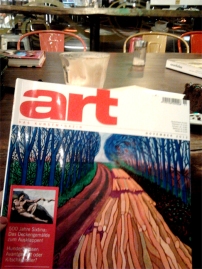
ART – magazine-cover
And on one fine day, as I flipped through one of these magazines, I discovered a feature on Pakistani artists and galleries! I was so surprised I did a little dance in my seat, whooped with joy and took photos with my phone to share it back home.
The magazine was ‘Art – Das Kunstmagazin‘ (September 2012), and so the article was in Deutsch. My basic ‘German I’ language course in 2004 only got me so far as to get minor details. Pointless details actually. But anyway it talked about the architect Naeem Pasha, featured work of the fabulous Shazia Sikander and also had snippets of discussion and images of work by Mahreen Zuberi and Imran Mudassar (both miniaturists) and Sophia Khawaja (printmaker). There was a picture of Quddsia Rahim (the curator at NCA’s Zahoor ul Akhlaq gallery) and another of Aqeel Solangi from the ‘30 Years of Rohtas‘ show that was held at the National Art Gallery (NAG).
I’ve posted some photos below. They’ve been taken from my cell phone so please enjoy the shit quality.
Lined up after Christmas, I hope to catch some time with the Owner of the gallery Selim Varol and talk about the artists he shows, how he knows some of them personally and generally how shit my blog is. Can’t wait!
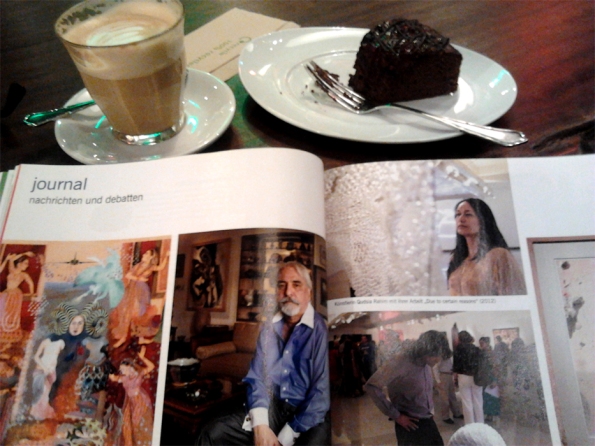
ART magazine with my latte and chocolate cake
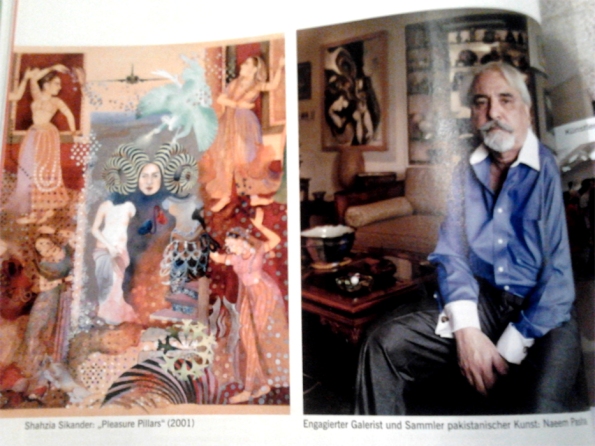
Shazia Sikander, Naeem Pasha in ART magazine – inset 1

Qudsia Rahim, Aqeel Solangi in ART magazine – inset 2

Murakami’s ‘Kafka On the Shore’ with my cake. What I was originally reading (and which the woman behind the cashier desk gave two thumbs up to!)
________________________
- Visit The s.a. Project Facebook page for regular updates
- Join in the much more interactive and constant discussion at twitter – SairaAnsariPK
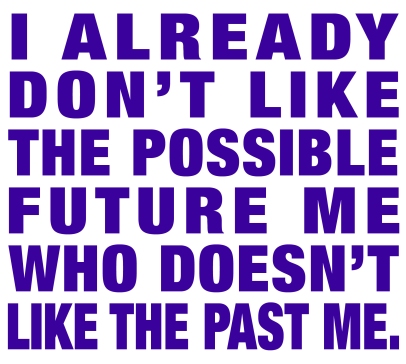
FUTURE ME, Digital Print, 2010 – Saira Ansari
Book 3, Act I Sc I
2 months, 12 days since the last post
Current location: Germany
Dream Status: Extraordinary, with lots of cobalt blue. Recorded strongest lucid dream to date in mid-October.
This post has been a long time coming. Eons in fact. It’s time to move on after having taken some brutally honest decisions in life. They are just as hard as they sound but it’s been empowering to shut Book 2 of Life.
I have now moved halfway across the world, on my own, and am, as I like to call it, ‘transitioning’ in cold Europe at the moment. I’m far far away from Brazil, and sunny Rio, a city I fell desperately in love with. And I’m not any closer to Lahore, a city I will always obsess about, but from which I will never get the kind of commitment I want.
I am, though, far more closer to redefining my own self… which is a curiously, ridiculously, interesting feeling. With a lot of possibilities. BAM: Suddenly the idea of a Ph.D is back on the table. It wasn’t really ever off it. Just slid under the mundane-ness of existence and dirty dishes. Let me get my MA dissertation cleared first though.
But more so, I get to be back on the blog, and back to my drawings, writings and scribbles, with a much broader agenda. I know, I know. I’ve threatened many comebacks on the blog. But this time I’m cooking up some stuff that I hope will come to some sort of geographical and mental positioning closer to what I love. So many mysteries! Don’t worry, I will still take a decorative crap on a piece of shit art review; Or gape in shock when some sensational art world gossip is exchanged with me via twitter DM’s; Or blog about young artists; or old ones; or homosexual ones; And I’m still writing. typing. what-evering.
There’s so much been happening in Pakistan in the Arts that I have been itching to write/applaud/bitch about. A multitude of shows, talks, awards, politics just waiting to be wordpressed. That I will get to, one by one, soon after this post.
The one thing I have never done (till now) is miss deadlines or commitments and I’m glad that the people I have worked with over the years have agreed…so far. Which is why I feel horrible about the last few months, with my own personal crises taking precedence over my writing. Horrible about not posting The Attic Studio review that I had harped on about and for which I had dragged the delightful Thesis students at NCA into a multi-crammed Skype meeting. I still plan to post it sooner or later. Horrible about the article I promised Raza Rumi at The Friday Times. That’s about 16 weeks late, and no longer relevant (sorry Raza!) And horrible for not sending in the write-up for the Curatorial Workshop website to Gemma Sharpe (exceptionally annoying since I actually did finish it and just never got around to the final proofreading stage). Or this that and the other for Art Now Pakistan (although I do believe that Nafisa Rizvi is no longer the editor, and instead Quddus Mirza is – so not really sure if they’re taking my writings anymore).
 And so this is my public apology for being such a shitty piece of Arse, and I promise I’ll deliver, those that still have a deliverable deadline. Or take on new assignments. And blog some more. Thankfully, the drawings and the dream journals have continued despite it being a ‘dead’ period in terms of other things.
And so this is my public apology for being such a shitty piece of Arse, and I promise I’ll deliver, those that still have a deliverable deadline. Or take on new assignments. And blog some more. Thankfully, the drawings and the dream journals have continued despite it being a ‘dead’ period in terms of other things.
*
Thank you everyone for your great emails, tweets, FB messages, google chats for getting me back on track. And thanks especially to the lovely words of support from the super awesome Umer Butt (Grey Noise) and Mohsin Shafi, as well as the delightful nudges of Fazal Rizvi, Gemma Sharpe (Vasl), Abdullah Qureshi (39K Gallery) and Hareem Sumbul.
With this I end this sappy excuse of a blogpost and move on towards business.
*
Till then do watch this video celebrating Pakistani Neo-Miniaturist Imran Qureshi as ‘Artist of the Year 2013’ by Deutsch + Guggenheim. It’s been directed by a friend and colleague, Shah Zaman Baloch. Read more about the award in the e-flux announcement.
________________________
- Visit The s.a. Project Facebook page for regular updates
- Join in the much more interactive and constant discussion at twitter – SairaAnsariPK

ArtRio 2012 – Pier Mauá, Rio de Janeiro.
Photos taken from my tiny pink camera and then from my cell phone when the camera battery died. The big Nikon camera was left home this time. I noted down a lot of names but have lost/forgotten many of them. It was just too much to absorb. The 6 hours of walking and the long commute to and back was so worth it. Met great people, artists and gallerists. Some of the work was great, some was crap. Some loud, some silent. Although as a fair ArtRio is very commercial, yet it did seem to have a more arty-vibe than that of Art Dubai (the only other ArtFair I’ve personally attended, not counting ArtRio 2011). Probably got to do with the kind of people who came and also the location.
—–
Spread across 80,730 square feet and four warehouses, the exhibition space housed 120 galleries – and my challenge to ‘do the fair’ in one day seemed like a pretty ludicrous idea. Post-fairwatching, my brain was tripping on colours, and my feet screaming to be let out my boots (which I had donned on for my art-vulture look). However, a fresh fruit cheesecake and a hotdog sustained me through my ambitious challenge and I managed to cram in as much as was physically possible. The entry ticket was priced like last year at R$ 30 (that’s approximately $15), which made the R$80 Fair Catalogue price very unreasonable. So I didn’t buy it.
Making my through – I got to see some great work from Brazilian masters, especially Modernist artists. I just love the texture and colour tones of the paintings made in the 70’s. It’s a large generalization to be sure, but hard to explain in any other way. But considering that half the galleries were Brazilian, I did get to see a lot of exciting local work – old as well as contemporary. My new favourite happens to be Vik Muniz – a New york based brazilian artist (a definition I wouldn’t mind attaching to my name!)
There were many big international contemporary ‘stars’ part of the fair, of course. I had many celebrity-awe moments – Picasso, Botero, Louise Bourgeois, Andy Warhol, Calder, Man Ray, Christo, On Kawara, Damien Hirst, Tracey Emin, Kara Walker, Murakami, Nan Goldin, Robert Rauschenberg, Roy Lichtenstein, Henry Moore...the list goes on. And the largest, fanciest booth happened to be of a NY based gallery. They have the artists and they have the money. But as usual, it was the small galleries that intrigued me with their displays.
I also got to meet a kooky local artist Franklin Cassaro, who’s solo show my sister and I attended about a month ago at Laura Alvim gallery in Ipanema. We fell in love with him. He twists silver foil and paper endlessly to make organic lifeforms. One of his wind and silver foil installation at the solo show had me mesmerized for quite a long time. I said hello, and shamelessly snuck in my website. (← Just like I did here too!)
The large sculpture warehouse at the end housed some very interesting pieces from the Gagosian collection that I had never seen before – for instance the Roy Liechtenstein sculptures. Nearly all the dramatically lit works were awe-inspiring, but I just seemed to have come at a wrong time. I tried admiring the Henry Moore bronze but a lady was hell-bent on posing next to it in one of her ‘vacation shots’. Then there were the American minders – sharks in black suits – that protected the artworks. The blond yelled and yelled and yelled at everyone to stay away from the works, and complained loudly in english about the local people. For some reason I seemed to have overheard my fair share of Americans speaking their thoughts out aloud in english, because they naturally assume that those around them won’t understand. Given, most Brazilians don’t speak English. But I do and my experience was constantly getting dumped in dirty laundry water with her commentary. Another thing that left an impression – the Damien Hirst piece ‘Moments of Weakness’: a glass cabinet with rows upon rows of sparkling manufactured diamonds – seemed loud, ostentatious. Maybe even vulgar. I don’t know why I felt that way, but I did. Nothing less from the master of bling, I suppose. The ladies, though, were stuck to it like his morbid butterflies on sugar-water piece.
What intrigued me about the fair the MOST was how I could relate, connect and contrast so many of the works with artworks of Pakistani artists. Sometimes it was the same channel of thought, sometimes it was strikingly the similar use of a medium, and sometimes it was the same imagery even. It just goes to show the universality of the language of art and the symbols we have come to associate with our existence over time. Back home I know people would quick to point out foul play and copycats, but I don’t agree. Sometimes, you just have a doppelgänger artist version of yourself out there.
There was much I saw and I wish to share and I could go on and on endlessly. But I’ll let you enjoy the photographs instead. Next stop…Bienal São Paulo! (Now to book a cheap flight….)
Click the photo below to be taken to the Public photo album on Facebook ↓
Or click this link: ArtRio 2012 Facebook Photo Album
This is a public album. Feel free to share the whole album or photos individually, but please remember to credit the images to Saira Ansari. There are just 3 or 4 photos in there that I didn’t take, but they have been credited to the ArtRio FB site they were taken from.
________________________
- Visit The s.a. Project Facebook page for regular updates
- Join in the much more interactive and constant discussion at twitter – SairaAnsariPK
The Attic Studio exhibition is the result of a self-initiated Open Studio Residency arranged by 4th year students of the National College of Arts (NCA). Tomorrow is the last day of the exhibit at the Alhamra Art Gallery (Lahore). Working for an external show this close to their thesis is an ambitious move, but all power to these art students who know that time spent in a studio is far more productive than ‘saving up’ for the thesis. It’s art, not virginity.
I’ll be talking with the young artists from the Attic Studio early next week and will share here their views and their work. Keep tuned. Bring some tea.
________________________
- Visit The s.a. Project Facebook page for regular updates
- Join in the much more interactive and constant discussion at twitter – SairaAnsariPK

‘Established in 1993, ArtAsiaPacific magazine is the leading English-language periodical covering contemporary art and culture from Asia, the Pacific and the Middle East. Published six times a year, AAP includes features, profiles, essays and reviews by experts from all over the world.‘ – AsiaArtPacific.com
Very recently I came across an article shared by a friend on Facebook. It was an offering by the esteemed art journal ArtAsiaPacific, simply titled ‘LAHORE‘ and penned by Ambreen Karamat. The author has a respectable academic background and experience and according to her LinkedIn profile is “Working as project/studio manager focusing on Rashid Rana’s mid career retrospective at Mohatta Palace Museum Karachi.” Yet, browsing through the article I was struck by its tunnel vision approach and decided to write a blogpost in response. It isn’t meant as an attack on the writer – it is simply negating an image of Lahore that I absolutely don’t agree with.
________________________
I admit I’m a cynic. Especially when it comes to the art world in Pakistan. And I like to question everything I read and see. I like to pick on discrepancies in opinions, mostly in art instruction and guidance for students and younger artists. I am the last person who will glorify an institution just for the sake of being patriotic. More so than ever, I am also aware how many negative elements are hindering progress in the country in all fields. The Arts suffer the most, predominantly due to lack of state support and funds.
But what I am not is a Nihilist.
I cannot oversee the amazing leaps and bounds we are making in the Arts, within the country and across the world. I cannot ignore the vast pool of skill, intellect and talent that our artists possess. And I absolutely cannot ignore how so many people, important and ordinary, are part of the art world despite assumptions that this is a small pocket. Amidst the many challenges they are faced with on a daily basis, they continue to push ahead and create their own niche.
Then comes this article by ArtAsiaPacific (AAP) that puts an ‘Afghanistan’ twist to the storytelling (for the lack of a better term.) It is hard to simply take a bite of it and gulp it down without a protest.
The article is largely catering to an audience that has absolutely no way of comparing on-ground realities with romanticized-horror reporting. But really, to read an article like this in AAP is deeply unsettling. The opening paragraph is vastly suggestive of the tone the article has taken, deciding for the reader what their opinion should be: a politically steeped one, depicting doomsday scenario.
The article then goes on to read: Hand-painted flora-and-fauna motifs, outlined with cut-outs of bright patent leather, embellish trucks, rickshaws and food stalls, alongside lively cinema posters showing women in suggestive postures and exaggeratedly valiant men.
Such raw, crude images are publicly acceptable in “mullah” culture, but when rendered by the fine artist, the same imagery is banned. Works with images of women with uncovered heads are censored at the Alhamra Art Gallery, run by the Lahore Arts Council. Private galleries are hesitant to show works with any element of nudity.
Hesitant to show any element of nudity? If anyone remembers my post ‘Naked – Literally and Figuratively’ I addressed this topic (from quite another angle actually), but went on to give numerous examples of contemporary artworks that contain the male and female nude. And these are only the works that I’m familiar with. Undoubtedly there are many more. I addressed the limitations of showing some works and the wild abandon with which others were displayed, but most of these have shown in Pakistan.
However, censoring ‘images of women with uncovered heads’ must stem from some story that I have not heard of. Because of the many many many shows I have attended since my student life in NCA, starting back in 2001, and my exposure to the galleries before that, this is not something I’ve noticed. I do know Colin David’s private exhibition of nudes was attacked by a group of miscreants in May 1990, and am painfully aware of the vociferous negation by extremist elements in society at many other instances. But I never heard of any other portraiture being censored, simply because it didn’t have a dupatta on its head!
In fact one of the most recent shows at Alhamra, ‘Mera Naam Hai Mohabbat (I AM LOVE)’ included themes of gender identification and gay pride. (Residency exhibition picture on left)
I completely agree with the author on one point though when she argues, “…national support for arts and culture is almost nil. Before 1995, the ministry for culture was joined with that of sports and tourism. In 2006, separate ministries for culture and sports were created and art world experts were called to draft a revised cultural policy, finalized in 2008—with no visible results as yet. Like other government branches, the ministry lacks a vision and a good leader. The current minister holds a master’s degree in agriculture. With a series of incompetent governments, it is still too early to expect a cohesive national policy for art.”
In fact my own thesis report talks about the house of mystery the ministry for Arts has been. In my opinion, the author is absolutely right in pointing out the key problem here, as without any form of state support and state acceptance, the brunt of work is shouldered by private bodies – which is good and bad in different aspects. And to top it off, a lack of policy leaves a weak infrastructure that is predisposed to abusive practices.
But then she goes on to state that, “In this chaotic scenario, Beacon House National University and the National College of Arts are producing a profusion of artists who struggle to exhibit in the limited spaces available. Gallery culture in Lahore is almost nonexistent, with a few fighting to survive. Most venues are commercial, selling to clients who walk in with swatches of cloth to match paintings to their interior decor.”
First of all I do not understand where this has come from. Much as I comment myself on the recklessly ‘commercial’ side of many galleries, business in fact is not slow. I’m the first to say that many of these galleries have their own issues, sometimes even ethical ones. But there are many spaces, big and small, which are showing work all year round. I receive numerous invitations via snail-mail, email and Facebook, cramming for attention. Student shows, solo shows, group shows, travelling shows, international shows, private collections, curated events, screenings, and now even performance. Aside from that, several people are exhibiting pop-up shows in non-gallery spaces every now and then also, utilizing their studios, homes, and other venues. This might not even be close to other Art Hub cities in the world in number or scale, but its there.
During my stint at teaching First Year NCA in 2010, I was constantly urging my students to catch this show or the next. I remember taking them to a show at Ejaz gallery, and there was barely room to move around because of the high attendance.
Yes, there are always those exhibitions that have paintings matching sofa covers for monied clientele, but there are also shows that have people going round a room to read just one line of script that is loaded with meaning. (see image on left)
All the people associated with the art world in Pakistan admit to the fact that times are increasingly difficult. Extremist tendencies are increasing in our daily lives at an alarming rate. There have been big blows to the academic art scene in Lahore recently – events that I have been asked by persons involved not to write about, much as they pain me deeply.
However, most of these woes in our art world are linked to economic hardships, production issues, finding the right buyers and gallery representation, and making a healthy living with art as the career of choice. Censorship is NOT high up on the list of issues that plague it.
And while the main commercial and production activity of art is centralized in cities like Lahore and Karachi, these are inundated with artists and craftsmen from across Pakistan, even those areas considered to be sensitive. Art institutions in Lahore, like National College of Arts (NCA), Beaconhouse National University (BNU), Punjab University Department of Art, are teeming with students from far-flung corners of the country. (Visit this link on my blog to see a list of more art institutes across Pakistan)
Again, the author goes on to write, “It is commendable that in these circumstances Lahore is nevertheless producing artists with international reputations, introducing new genres to the world, such as the “Neo-Contemporary Miniature.” Locally, however, most artists are going unnoticed. Rashid Rana, who has made waves internationally with his large images composed of micro ones, is booked for international exhibitions and talks for the next two years, but is largely overlooked at home.
The reason is obvious, yet not articulated. Eminent Pakistani artists hardly exhibit their works at home due to the limited number of local platforms, and the dearth of curators, agents and art dealers. Artists of international repute, such as Imran Qureshi, Bani Abidi, Naiza Khan and Hamra Abbas, have established a network of buyers and dealers abroad”
On the contrary, ‘Neo-Contemporary miniature’ giants like Imran Qureshi and New Media giants like Bani Abidi and Rashid Rana are widely applauded across Pakistan and respected by students, and they do show their works in the country as well, including venues in Lahore.
Likewise, other artists of international repute (or international residence) also continue to show in Lahore – for example: Hamra Abbas, Naiza Khan Khalil Chishti, Ruby Chishti, Faiza Butt, Huma Mulji, Risham Syed, Ayaz Jokhio, Iqbal Geoffrey, Farida Batool and many more have exhibited in Lahore within the last 2 years alone.
Exhibits also include book launches by art and literary figures such as Virginia Whiles, Muhammad Hanif and more.
And finally the article states: “Following their lead, the majority of artists in Pakistan wait to be picked up by either New York’s Aicon Gallery, Green Cardamom in London or Gandhara Art Gallery in Hong Kong.”
It is indeed a great experience to show on international platforms through curated shows, or gallery representations. It provides an opportunity to expand one’s own vision as well as share ideas with those who have never seen or heard of our work. And while many of our artists are showing with mostly 3 galleries, it is a gross over-statement that automatically assumes that all local artists want only this. Artists like R. M. Naeem have an illustrious career and an almost cult-ish following amongst his students and peers. Many of his protégés also show with these galleries. But he himself does not wait to be picked up. On the contrary he’s trying to create a platform that enables local artists to intermingle with international ones in his own curated residencies and exhibitions. It is one of the very few residencies taking place in Pakistan and is entirely self-funded.
The thing is, if we cannot learn to look beyond the ‘Arab Springs’ version of the story of every country’s art sphere, then there really is no hope for unbiased, non-objective dialogue. We will continue to be stuck knee-deep in the orientalist mentality that still plagues are own writers.
We keep looking at ourselves as how the outsider might see us in a glimpse. But we don’t live in a glimpse. We are so much more.
________________________
- Visit The s.a. Project facebook page for more regular updates
- Join in the discussion at twitter – SairaAnsariPK






